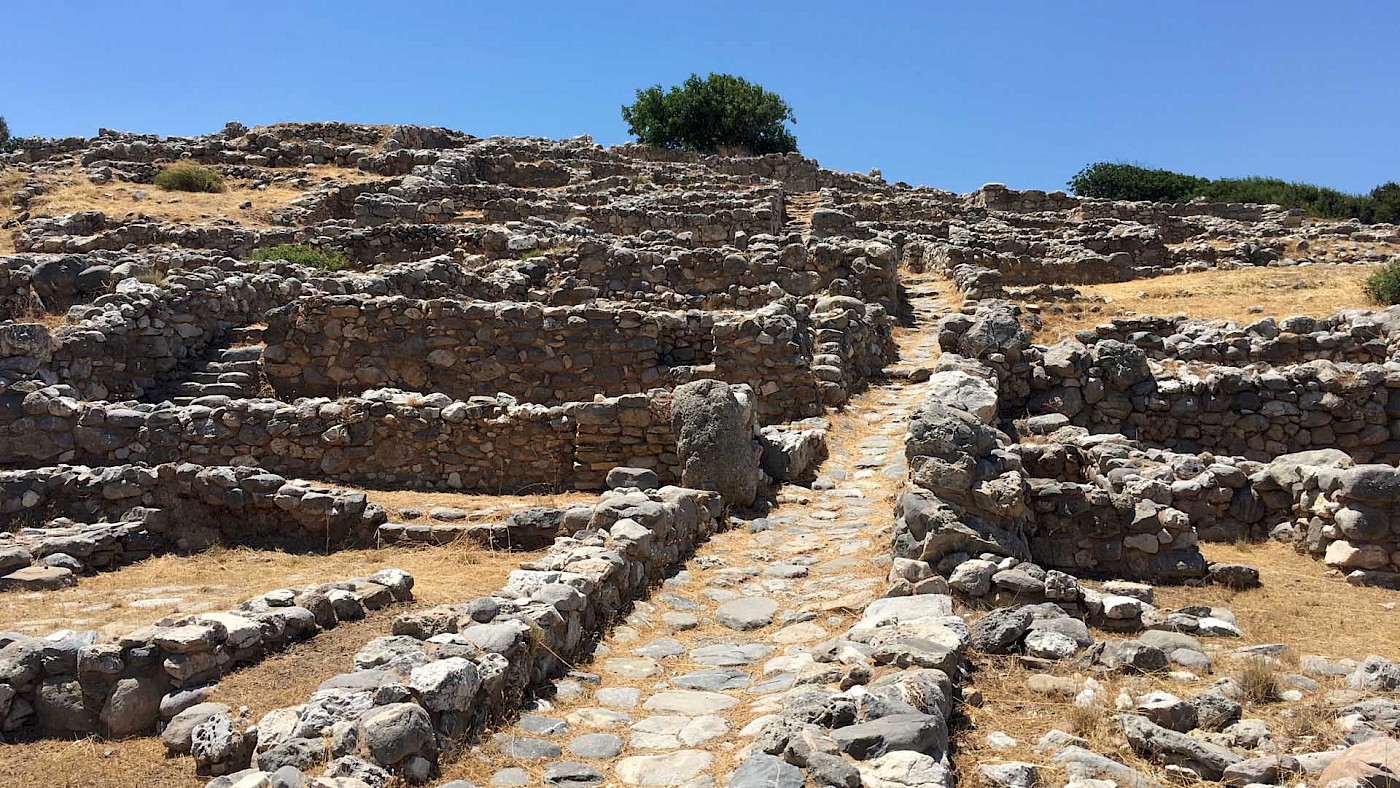Crete is an absolute paradise if you love exploring archaeological sites. During the heyday of Minoan civilization, or ca. 1900 to 1450 BC, Crete was, as Younger and Rehak put it, “surprisingly urbanized.” As they explain (2008, pp. 141-142):
Along the north coast, from modern Chania to Siteia, there would have been a string of palaces: presumably Chania and Rhethymnon, where important buildings have been excavated, and then Knossos, Malia, Gournia, and Petras, all approximately 25-40 miles apart. Some traces of roads have been discovered, sometimes with watchtowers, and a whole string of small settlements, “villas”, and farms.
I’ve written before about Knossos and Malia, two large and important centres. Smaller, but certainly not less impressive, is the town of Gournia, located on the Isthmus of Ierepetra and in close proximity to the sea. It was excavated early in the twentieth century by the American archaeologist Harriet Boyd-Hawes.
An important Minoan town
“Gournia” is the modern name for the town; we don’t know what it was called in ancient times. Because it is situated near Crete’s narrowest point, a lot of traffic must have flowed through it, and the finds from the site certainly suggest it was important. The Minoan town itself occupies a large hill, with a large and impressive building complex at the very top, Gournia’s “palace”. Like the other Minoan palaces, this structure must have served as the town’s administrative centre.
The buildings on the hill are well preserved. The superstructures, which would have mostly consisted of mudbrick and wood, have naturally disappeared, but the foundations and lower sections of walls are visible. Gournia consists of a conglemeration of structures, intercut by a number of narrow streets that all seem to lead to the palace at the top (see the photos in the gallery, below).
Wandering through the streets and alleys of the site, you don’t need much imagination to picture what life may have once been like in Gournia. If you’ve been to modern Greek villages or even Italian towns like Capri, you know what to expect. The streets aren’t wide enough for two people to walk side by side; there are walls everywhere, and occasionally short flights of steps that lead to doors on a higher level.
Behind the walls are the residences of Gournia’s inhabitants, but also workshops and store rooms. The people who lived here were merchants and craftsmen, engaged in trade and the manufacture of pottery, metal tools, and the like. The large palatial structure at the top of the hill would have been the political and religious heart of the community. As at Knossos and Malia, there was a relatively large court there that would have been used for various purposes.
One of the characteristics of the Minoan culture on Crete is that during their heyday, settlements seem to have been unfortified. But it may well be that fortifications were unnecessary: in the case of Gournia, we have a town with buildings tightly packed together; the narrow streets would have afforded an attacker little protection. The buildings all had flat roofs, and in case of an attack, the inhabitants could simply bar their doors and hurl stones and other projectiles from above. Defensive architecture without the need for gates and towers.
Touching the past
If there’s any place in Crete where you feel like you can get really close to the Bronze Age inhabitants of the island, Gournia is it. There is the impressive palace at the top of the hill, but also the regular homes and workshops of the people who lived around it. At the very foot of the hill are also the house-shaped tombs where some of the dead were buried.
Gournia is a place with history and meaning, and one well worth your time to seek out and explore. As always, the easiest way to reach the site is by renting a car, but the site can also be reached by bus or taxi. The visitor centre has no information on offer, but there are plenty of signs dotted around the site that give a good amount of information about various points of interest.
Gallery
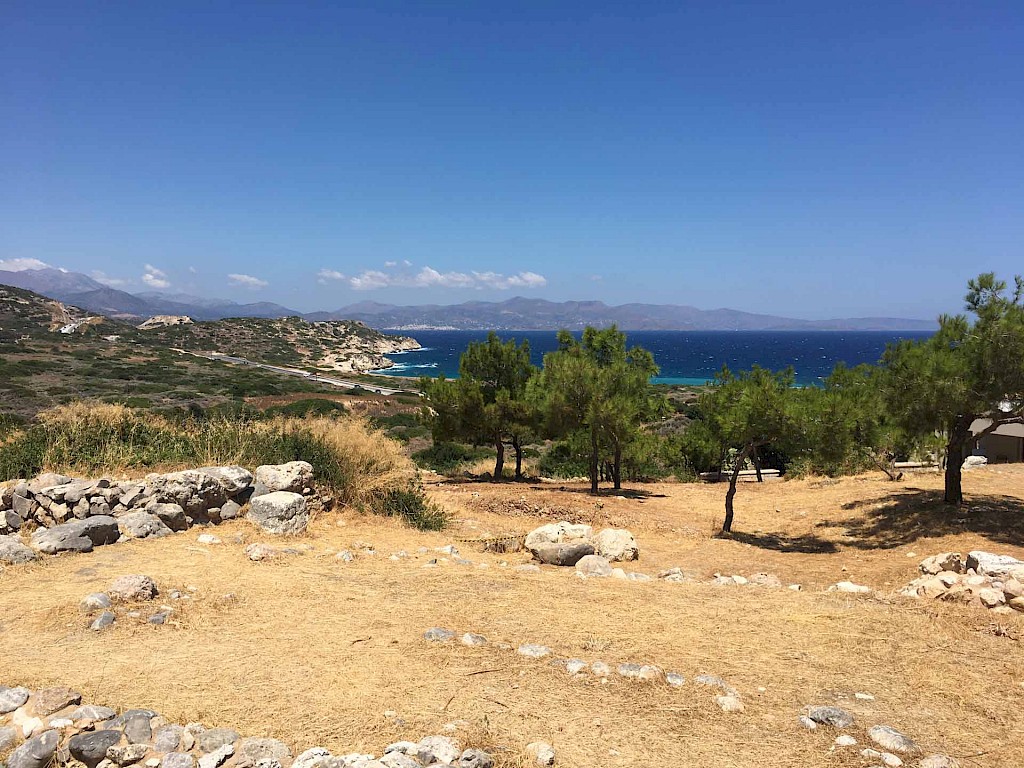
A view of the sea
Gournia is located on Crete’s northern coast within easy reach of the Aegean Sea, as you can see here. Remains of a harbour have been unearthed nearby that must have belonged to Gournia.
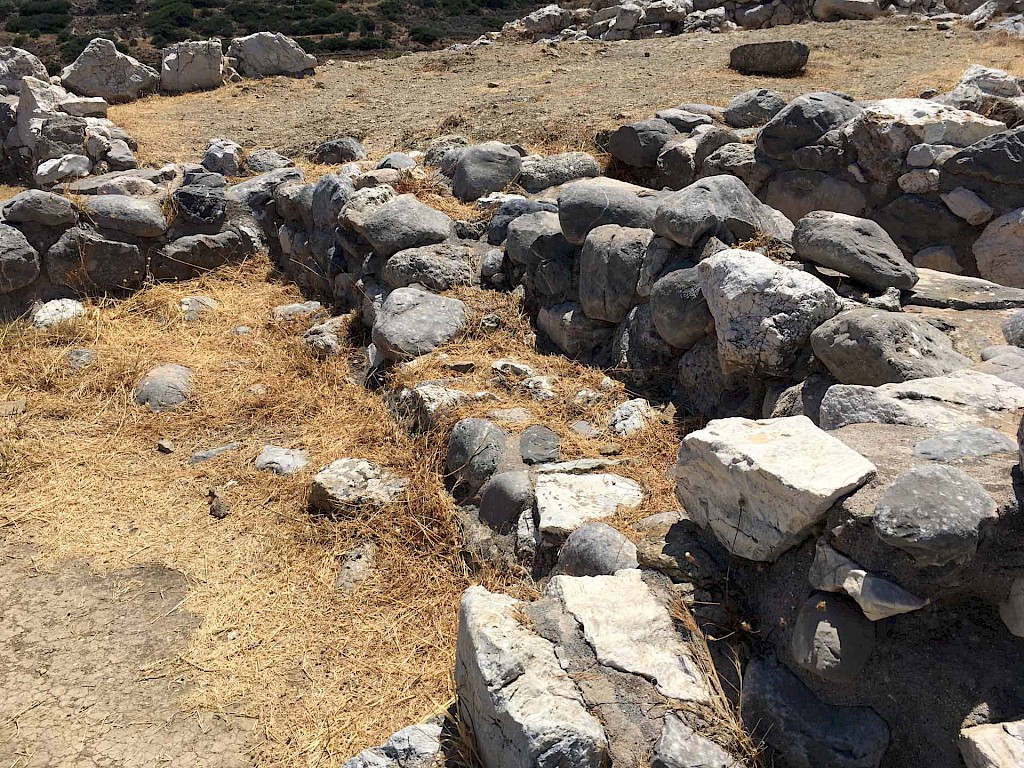
The Mycenaean shrine
Not far from the “palace” at the top of the hill, a narrow side street leads up to a shrine of the Mycenaean (i.e. Late Bronze) era, ca. 1400-1200 BC. The photo shows the inside of the shrine’s single room and focuses on the bench along one of the walls. Votive objects were placed on this bench. Among the objects recovered fom this room are three statuettes of goddesses, as well as lamp stands decorated with snakes.
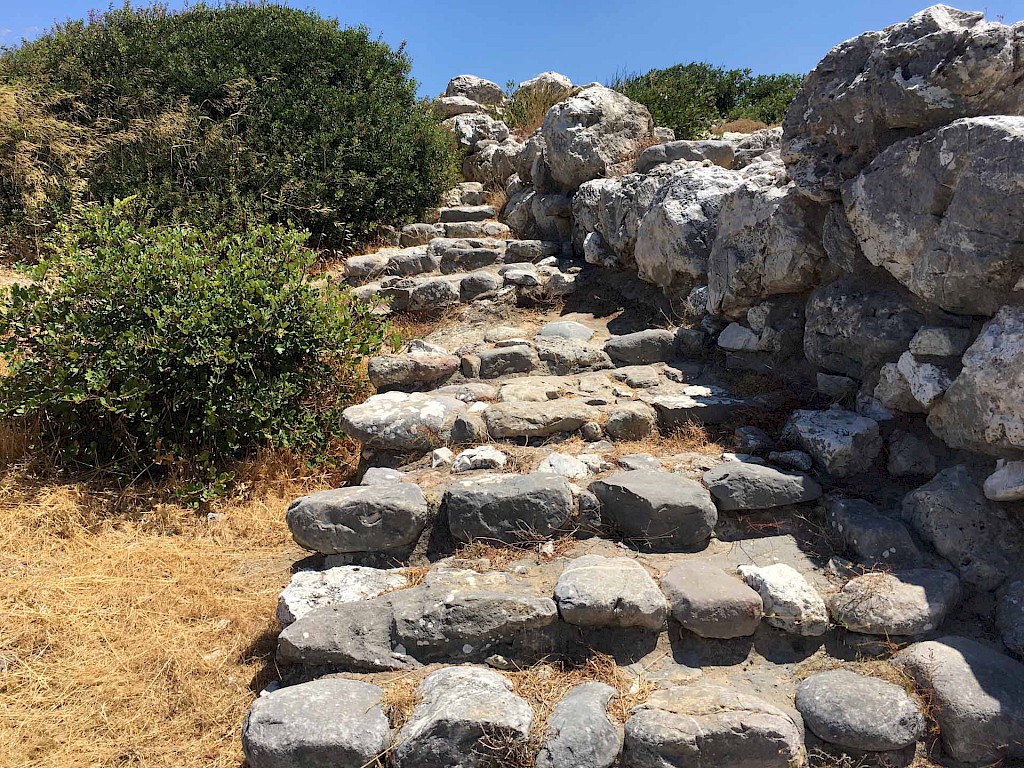
Street going up
Streets are cobbeled in Gournia. Streets going up or down tend to have steps, like the street depicted here. Wheeled vehicles of some sort, such as carts, would have been impossible to push into the town. Whatever the inhabitants had to transport, they would have had to carry it using either human or animal (donkey) labour.
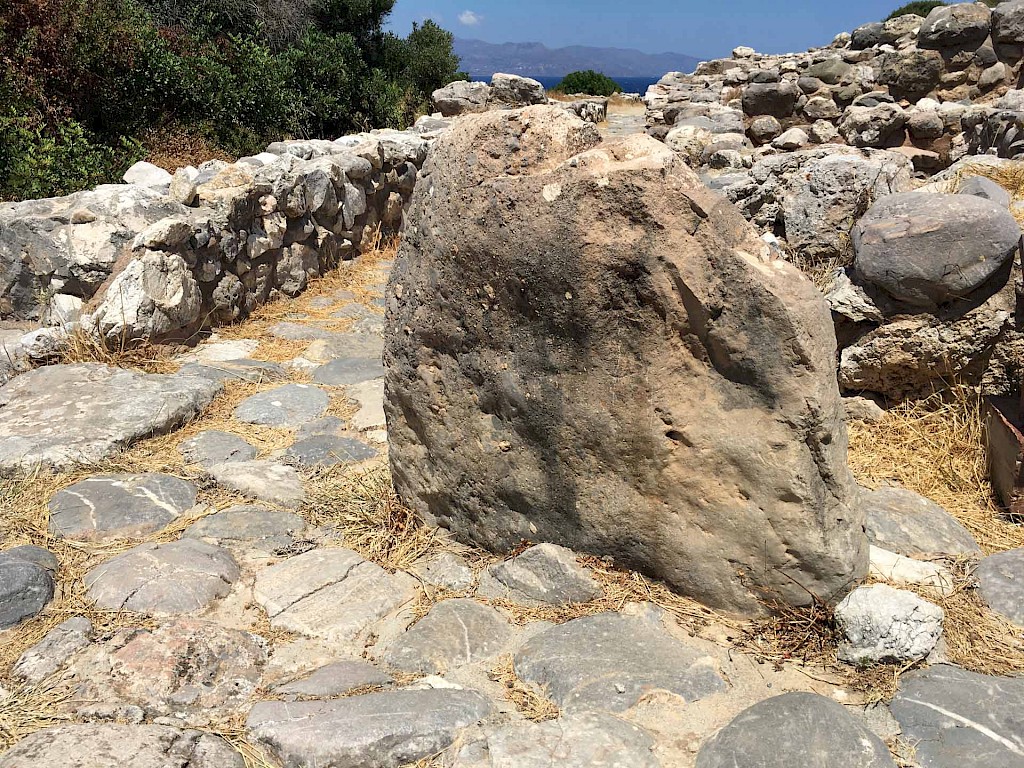
A sacred stone
As you make your way up to the “palace”, you’ll eventually turn the corner and see this: a large upright stone set into the street. It is a sacred stone or baetyl. They are well known from seals and gems, where they are often depicted with a human figure kneeling in front of it or seeming to embrace it. Closeby was a kernos (see below), located at the base of a wall that forms the outer perimeter of the “palace”. Clearly, this corner had a religious significance.
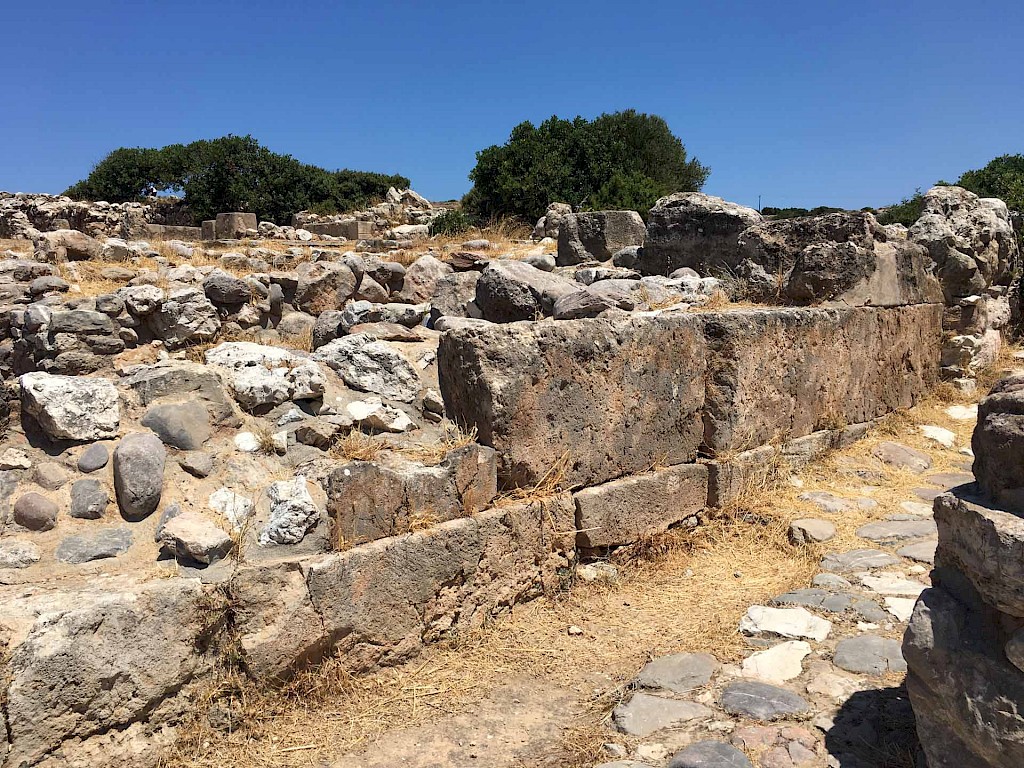
Wall of the "palace"
This is part of the outer wall of the “palace” at the top of the hill. Whereas most of the visible walls in Gournia are roughly worked or even unworked, these large stone blocks are carefully dressed and fitted.

The ruins of Gournia's "palace"
A view of the ruins of the “palace” at the top of the hill, seen from the outside. Note the steps on the right. As was probably the case at the other Minoan palatial complexes, these steps may have been used as seats for people watching whatever went on in the palace’s court, and has been referred to as a “theatral area”.
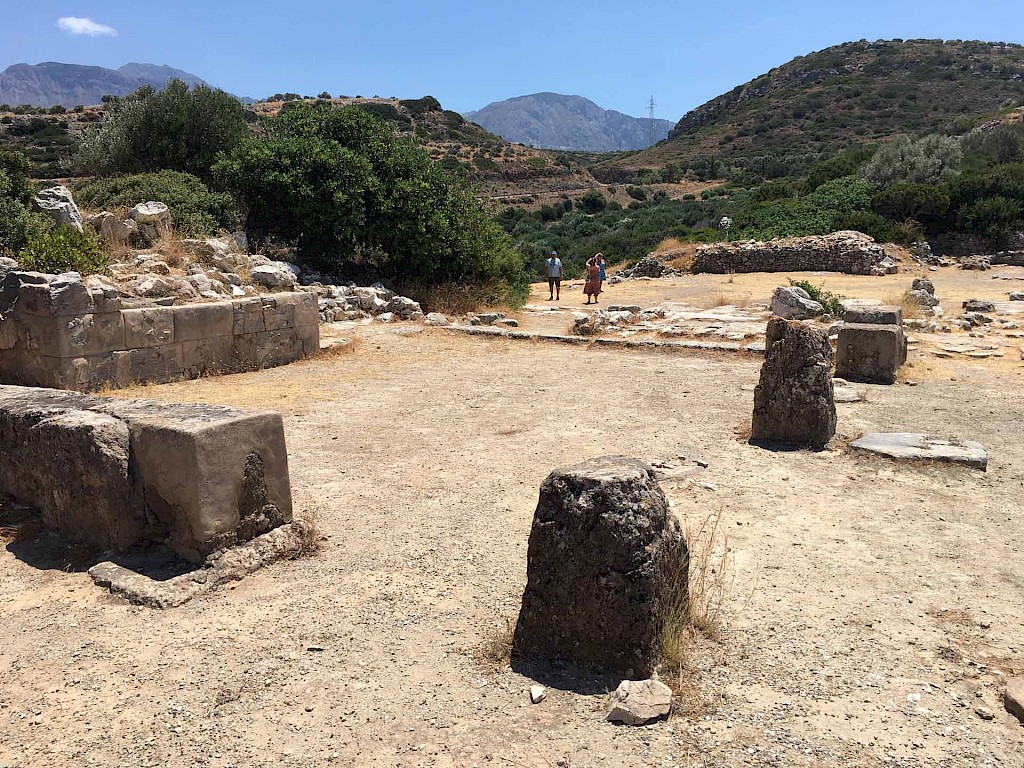
Inside the "palace"
The “palace” of Gournia, located at the heart of the settlement and occupying the highest and most commanding place of the hill, with an excellent view of the surrounding territory, was the largest structure in town. It no doubt served as the town’s administrative centre, and perhaps also as the home of its leader or leading families.
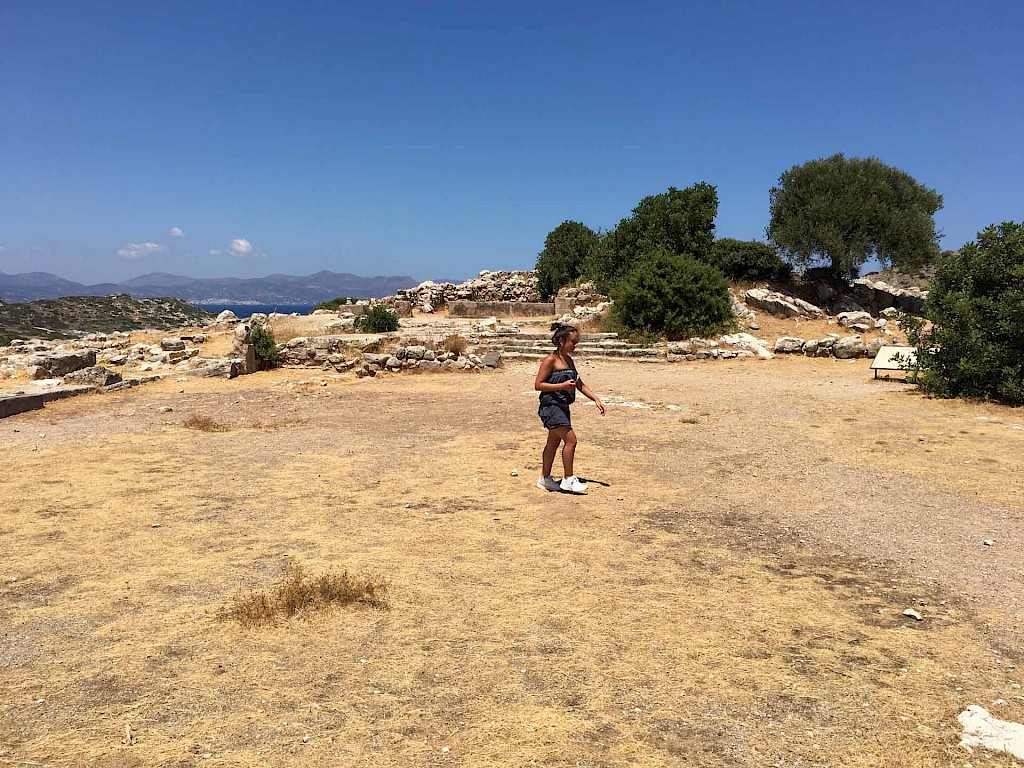
The court
A view of the rectangular court in front of the palace and partially surrounded by it. A large stone object in the shape of bull’s horns was unearthed it; possibly, these were “Horns of Consecration” that had fallen from the building’s roof when it had fallen into disuse. As at other Minoan centres, the court probably fulfilled a number of important communal functions.
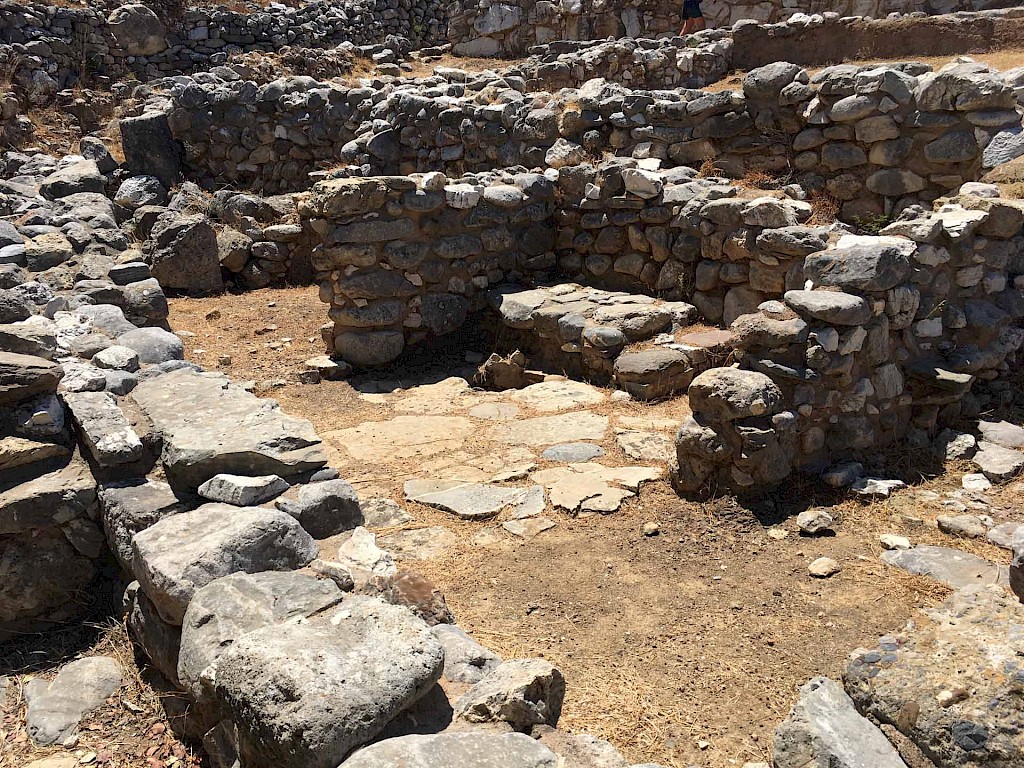
A look inside a building
Gournia consists of a large number of structures that are all built one against the other, with clusters of buildings separated from each other via narrow streets. This picture shows the inside of one of these structures. Finds from inside the rooms usually tell us about the purpose. Some “rooms” turn out to be small courts, while others were used for domestic purposes. Some rooms were used for storage, while others were clearly workships used to make metal tools, pottery, and so on.
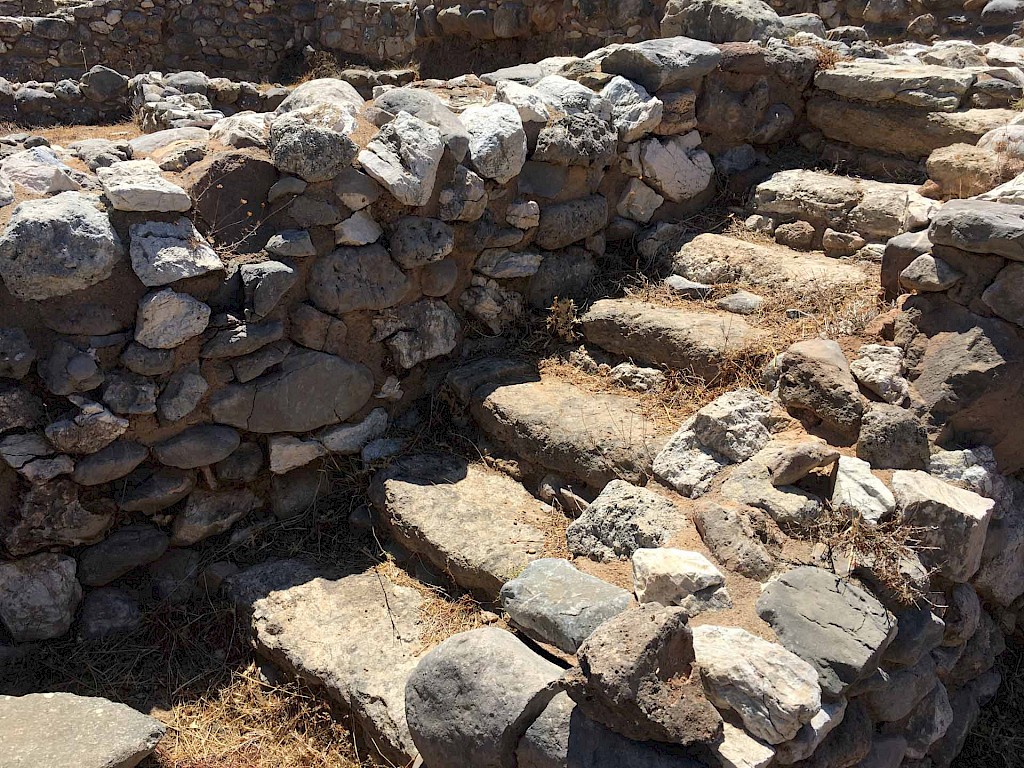
Steps leading up
These are steps that would have led up to a higher floor inside a building. Aside from these interior flights of steps, many of the houses that line the narrow streets have entrances that can only be reached by a short flight of steps. Some buildings have multiple entrances; a door at ground level might give access to the domestic area of a building from a cul-de-sac, while the main entrance (perhaps for customers?) could be reached from one of the main streets via a flight of steps like this.
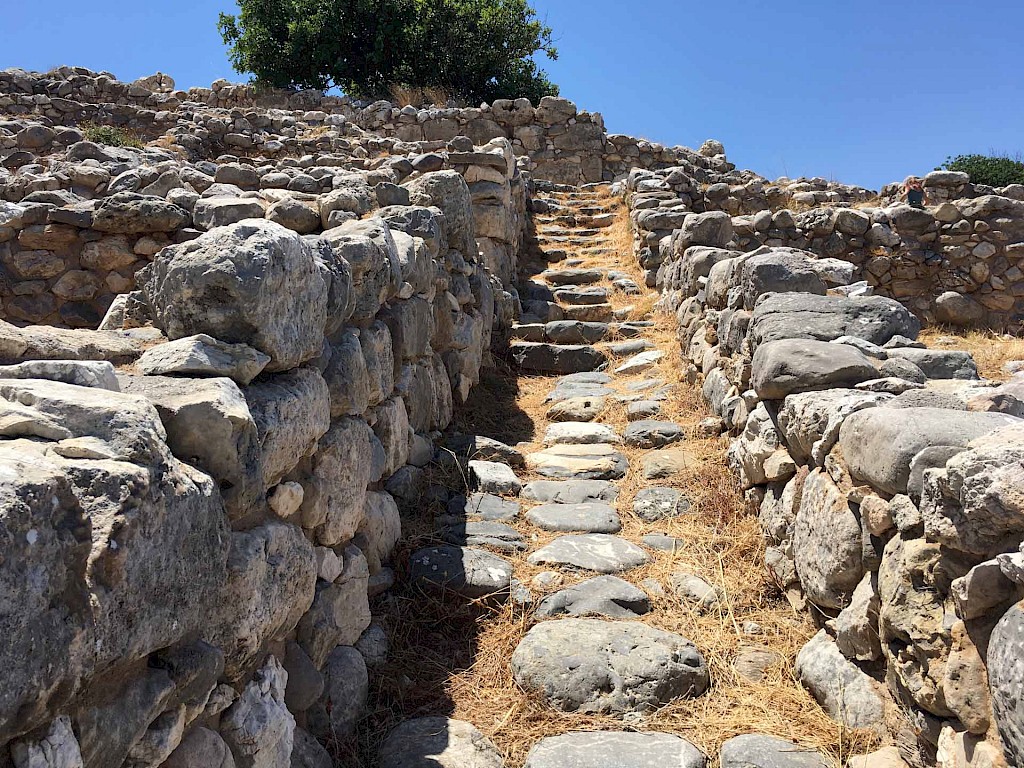
A view up a street
Gournia has been carefully planned by its builders, with the administrative centre (i.e. the “palace”) at the top of the hill, like a spider in the centre of a web consisting of narrow streets.
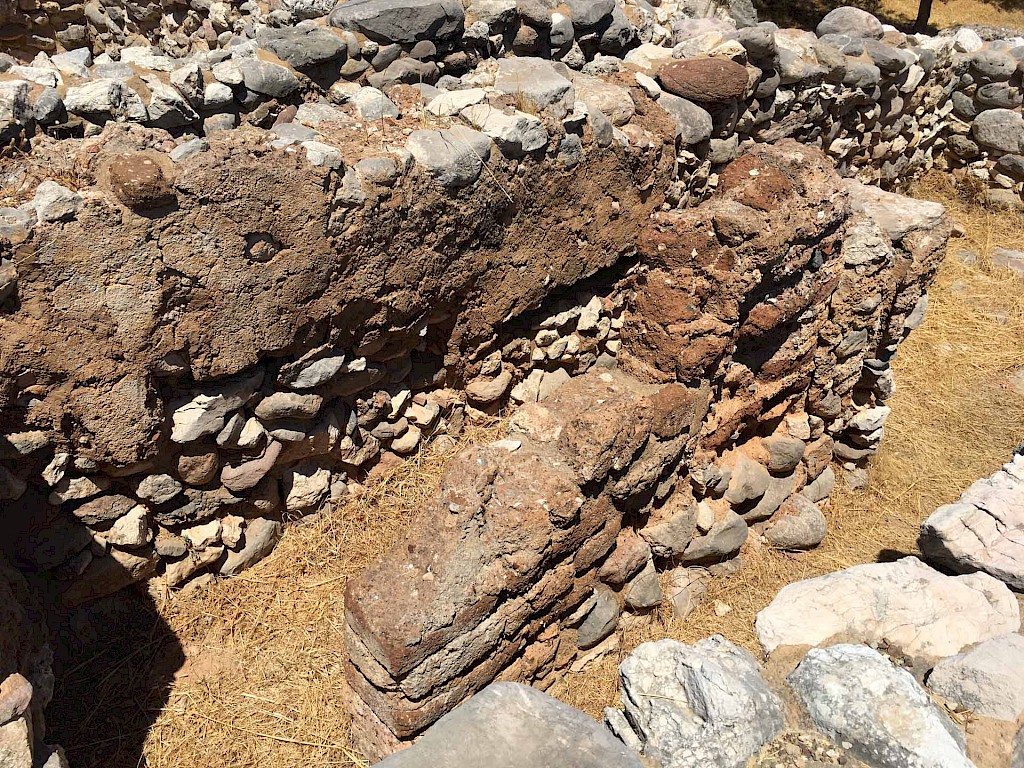
A mudbrick wall
This is a view inside a basement area (room 16) of House AC in Gournia. Note the centre wall, which has a stone socle topped by a mudbrick superstructure. It may have been added to reinforce the floor above, which would probably have been made of wooden planks. While the lower portions of the walls in Gournia were generally made of stone, like elsewhere mudbrick would have been used for the upper stories.
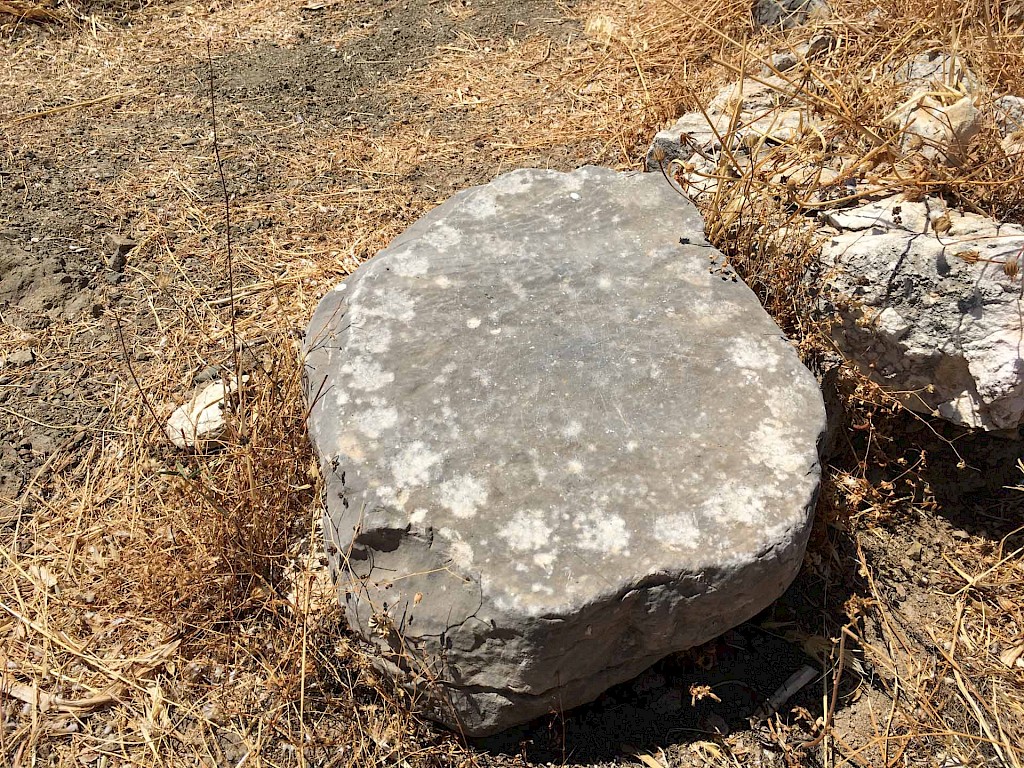
A kernos
This strange object is a kernos. The earliest examples of these date back to the Neolithic and they remained popular throughout the Bronze Age and into the historic era. They were also made of pottery, in the form of a number of small vessels arranged in the shape of a ring. This example, like its Stone Age predecessors, is made from stone, more or less circular in shape and with a flat top, with a ring of hollows along the edge. Small offerings were deposited in the hollows. This example was found near the house-shaped tombs at the foot of the hill; no doubt the offerings were intended for the deceased.
